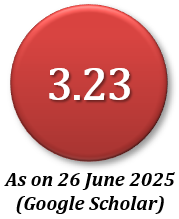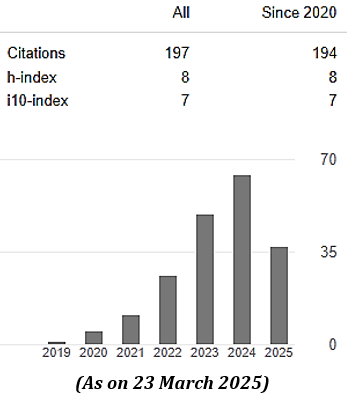Experimental Study of Water Collection from Plume of an Induced-Draft Counter-Flow Cooling Tower Using Space Charge Injection
Abstract
Plume collection from cooling towers can be a reliable solution to the water scarcity problem faced in many regions around the world. Meshes are one of the most proposed collectors in this regard that rely upon inertial collision for droplet capture and are inherently limited by aerodynamics. This study quantifies the effect of electrical forces on water collection from the plume of an Induced Draft Counter Flow (IDCF) Cooling Tower by introducing sets of copper tubes at the exit of the tower. The imparting of net charge to the exhaust plume by instigating space charge directs the vapor towards the inside wall of copper tube forming water droplets. This arrangement instead of a mesh or net system, creates a lesser obstruction to flow. Fabrication of fill/packing with a corrugated wave pattern using PVC plastic demonstrates satisfactory cooling performance of the tower. An optimized L/G ratio is found to exist for maximum collection efficiency of water from plume at definite entering fluid temperatures by investigating with the entering warm water temperatures at 40°C, 45°C and 50°C while the dry bulb temperature of air ranges from 23.5°C to 30.1°C. The electricity consumption for this arrangement fluctuates from 2.78 kWh/m3 to 5.13 kWh/m3 for two L/G ratios (23.5 and 28.3). Where maximum collection percentage occurs at two different entering fluid temperatures, the power expended is below the minimum used for typical desalination plants.
Downloads
References
Bourouni, K., Bassem, M. M., & Chaïbi, M. T. (2008). Numerical study of coupled heat and mass transfer in geothermal water cooling tower. Energy Conversion and Management, 49(5), 988–994. DOI:10.1016/j.enconman.2007.10.003
Carson, J. E. (1980). The Atmospheric Impacts of Evaporative Cooling Systems. In Atmospheric Pollution 1980: Proceedings of the 14th International Colloquium, UNESCO Building, Paris, France, May 5-8, 1980 (pp. 37–42). Amsterdam, Netherlands: Elsevier Scientific Publishing Company.
Damak, M., & Varanasi, K. K. (2018). Electrostatically driven fog collection using space charge injection. Science Advances, 4(6), eaao5323. DOI:10.1126/sciadv.aao5323
González Pedraza, O. J., Pacheco Ibarra, J. J., Rubio-Maya, C., Galván González, S. R., & Rangel Arista, J. A. (2018). Numerical study of the drift and evaporation of water droplets cooled down by a forced stream of air. Applied Thermal Engineering, 142, 292–302. DOI:10.1016/j.applthermaleng.2018.07.011
Huff, F. A., Beebe, R. C., Jones, D. M. A., Morgan, G. M., Jr., & Semonin, R. G. (1971). Effect of Cooling Tower Effluents on Atmospheric Conditions in Northeastern Illinois. Source: https://www.ideals.illinois.edu/bitstream/handle/2142/94436/ISWSC-100.pdf?sequence=1
Kraemer, H. F., & Johnstone, H. F. (1955). Collection of Aerosol Particles in Presence of Electrostatic Fields. Industrial & Engineering Chemistry, 47(12), 2426–2434. DOI:10.1021/ie50552a020
Liao, J., Xie, X., Nemer, H., Claridge, D. E., & Culp, C. H. (2019). A simplified methodology to optimize the cooling tower approach temperature control schedule in a cooling system. Energy Conversion and Management, 199, 111950. DOI:10.1016/j.enconman.2019.111950
Naik, B. K., & Muthukumar, P. (2017). A novel approach for performance assessment of mechanical draft wet cooling towers. Applied Thermal Engineering, 121, 14–26. DOI:10.1016/j.applthermaleng.2017.04.042
Novianarenti, E., Setyono, G., & Safitra, A. G. (2019). Experimental Study of The Performance Characteristic an Induced Draft Cooling Tower with Variates Fillings. IOP Conference Series: Materials Science and Engineering, 462, 012027. DOI:10.1088/1757-899x/462/1/012027
Parker, K. (2003). Electrical Operation of Electrostatic Precipitators (Energy Engineering). London, United Kingdom: The Institution of Engineering and Technology.
Perry, R. H., & Green, D. W. (1997). Perry’s Chemical Engineer’s Handbook (8th ed.). Kansas, USA: McGraw-Hill Professional Pub.
Reznikov, M. (2003). Dielectrophoretic Dehumidification of Gas Stream in Low and Moderate Electrical Fields. Presented at the ESA-IEEE Joint Meeting of Electrostatics (pp. 230-240), Little Rock, AR, USA.
Reznikov, M. (2014). Electrically Enhanced Condensation I: Effects of Corona Discharge. IEEE Transactions on Industry Applications, 51(2), 1137–1145. DOI:10.1109/tia.2014.2354734
Reznikov, M. (2015). Electrically Enhanced Harvesting of Water Vapor from The Air. Presented at the ESA Annual Meeting on Electrostatics.
Saber, H. A., & Maree, I. E. (2019). Experimental study on thermal performance of counter flow wet cooling tower and effect of fins angle. Anbar Journal of Engineering Science, 8(1), 1–8. Source: https://www.iasj.net/iasj?func=fulltext&aId=169264
Shublaq, M., & Sleiti, A. K. (2020). Experimental analysis of water evaporation losses in cooling towers using filters. Applied Thermal Engineering, 175, 115418. DOI:10.1016/j.applthermaleng.2020.115418
Sundén, A. E. K., Støchkel, K., Panja, S., Kadhane, U., Hvelplund, P., Nielsen, S. B., … Hansen, K. (2009). Heat capacities of freely evaporating charged water clusters. The Journal of Chemical Physics, 130(22), 224308. DOI:10.1063/1.3149784
Uchiyama, H., & Jyumonji, M. (1995). Field experiments of an electrostatic fog-liquefier. Journal of Electrostatics, 35(1), 133–143. DOI:10.1016/0304-3886(95)00019-7
Veldhuizen, H., & Ledbetter, J. (1971). Cooling Tower Fog: Control and Abatement. Journal of the Air Pollution Control Association, 21(1), 21–24. DOI:10.1080/00022470.1971.10469490
Wakil, M. M. E. (1985). Power Plant Technology (Rev. ed.). New York, St. Louis, San Francisco: Mc Graw-Hill Book Company.
Williamson, N., Behnia, M., & Armfield, S. (2008). Comparison of a 2D axisymmetric CFD model of a natural draft wet cooling tower and a 1D model. International Journal of Heat and Mass Transfer, 51(9–10), 2227–2236. DOI: 10.1016/j.ijheatmasstransfer.2007.11.008
Yu, F. (2005). Modified Kelvin–Thomson equation considering ion-dipole interaction: Comparison with observed ion-clustering enthalpies and entropies. The Journal of Chemical Physics, 122(8), 084503. DOI:10.1063/1.1845395
MIJST follows the open access policy.

This work is licensed under a Creative Commons Attribution-NonCommercial 4.0 International License. This allows anyone to copy, share, distribute, and modify the work for non-commercial purposes, where the original work and source should be properly credited.
















